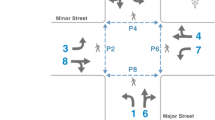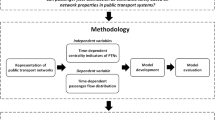Abstract
In the last decades, the socio-demographic evolution of the population has substantially changed mobility demand, posing new challenges in minimizing urban congestion and reducing environmental impact. In this scenario, understanding how different modes of transport can efficiently share (partially or totally) a common infrastructure is crucial for urban development. To this aim, we present a stochastic model-based analysis of critical intersections shared by tram traffic and private traffic, combining a microscopic model of the former with a macroscopic model of the latter. Advanced simulation tools are typically used for such kind of analyses, by playing various traffic scenarios. However, simulation is not an exhaustive approach, and some critical, possibly rare, event may be ignored. For this reason, our aim is instead to adopt suitable analytical solution techniques and tools that can support instead a complete, exhaustive analysis, so being able to take into account rare events as well. Transient analysis of the overall traffic model using the method of stochastic state classes is adopted to support the evaluation of relevant performance measures, namely the probability of traffic congestion over time and the average number of private vehicles in the queue over time. A sensitivity analysis is performed with respect to multiple parameters, notably including the arrival rate of private vehicles, the frequency of tram rides, and the time needed to recover from traffic congestion.






Similar content being viewed by others
Notes
By traffic congestion we identify the situation when the number of vehicles arriving is higher than the number of vehicles that can flow across the intersection.
References
ACEA (2016) The 2030 urban mobility challenge. Technical report, European Automobile Manufacturers Association
Agarwal A, Lämmel G (2016) Modeling seepage behavior of smaller vehicles in mixed traffic conditions using an agent based simulation. Transp Dev Econ 2(2):12
Albrecht AR, Howlett PG, Pudney PJ, Vu X (2013) Energy-efficient train control: from local convexity to global optimization and uniqueness. Automatica 49(10):3072–3078
Bernardi S, Campos J, Merseguer J (2011) Timing-failure risk assessment of UML design using Time Petri Net bound techniques. IEEE Trans Ind Inform 7(1):90–104
Biagi M, Carnevali L, Paolieri M, Vicario E (2017) Performability evaluation of the ERTMS/ETCS-level 3. Transp Res Part C Emerg Technol 82:314–336
Carnevali L, Grassi L, Vicario E (2009) State-density functions over DBM domains in the analysis of non-Markovian models. IEEE Trans Softw Eng 35(2):178–194
Carnevali L, Flammini F, Paolieri M, Vicario E (2015) Non-Markovian performability evaluation of ERTMS/ETCS level 3. In: Lecture notes in computer science 9272, EPEW 2015. Springer, pp 47–62
Carnevali L, Fantechi A, Gori G, Vicario E (2018) Analysis of a road/tramway intersection by the ORIS tool. In: International conference on verification and evaluation of computer and communication systems. Springer, pp 185–199
Charypar D, Axhausen K, Nagel K (2007) Event-driven queue-based traffic flow microsimulation. Transport Res Res 2003:35–40
Choi H, Kulkarni VG, Trivedi KS (1994) Markov regenerative stochastic Petri nets. Perform Eval 20(1–3):333–357
Dobler C, Lämmel G (2013) Integration of a multi-modal simulation module into a framework for large-scale transport systems simulation. In: Pedestrian and evacuation dynamics 2012. Springer, pp 739–754
ERTRAC (2009) ERTRAC road transport scenario 2030+ “road to implementation”. Technical report, European Road Transport Research Advisory Council
Fujii H, Uchida H, Yoshimura S (2017) Agent-based simulation framework for mixed traffic of cars, pedestrians and trams. Transp Res C Emerg Technol 85:234–248
Galpin V, Zon N, Wilsdorf P, Gilmore S (2018) Mesoscopic modelling of pedestrian movement using C arma and its tools. ACM Trans Model Comput Simul 28:11
Gawron C (1998) An iterative algorithm to determine the dynamic user equilibrium in a traffic simulation model. Int J Mod Phys C 9(3):393–407
Ghazel M (2009) Using stochastic Petri nets for level-crossing collision risk assessment. IEEE Trans Intell Transp Syst 10(4):668–677
Ghazel M, El-Koursi E (2014) Two-half-barrier level crossings versus four-half-barrier level crossings: a comparative risk analysis study. IEEE Trans Intell Transp Syst 15(3):1123–1133
González-Gil A, Palacin R, Batty P, Powell J (2014) A systems approach to reduce urban rail energy consumption. Energy Convers Manag 80:509–524
Higgins A, Kozan E, Ferreira L (1996) Optimal scheduling of trains on a single line track. Transp Res B Methodol 30(2):147–161
Horváth A, Paolieri M, Ridi L, Vicario E (2012) Transient analysis of non-Markovian models using stochastic state classes. Perform Eval 69(7–8):315–335
Huang Y, Weng Y, Zhou M (2010) Critical scenarios and their identification in parallel railroad level crossing traffic control systems. IEEE Trans Intell Transp Syst 11(4):968–977
Kerner BS, Klenov SL, Wolf DE (2002) Cellular automata approach to three-phase traffic theory. J Phys A Math Gen 35(47):9971–10013
Krajzewicz D, Hertkorn G, Rössel C, Wagner P (2002) SUMO (Simulation of Urban MObility)-an open-source traffic simulation. In: 4th middle east symposium on simulation and modelling, pp 183–187
Krajzewicz D, Erdmann J, Behrisch M, Bieker L (2012) Recent development and applications of SUMO-Simulation of Urban MObility. Int J Adv Syst Meas 5(3&4):128–138
Krajzewicz D, Erdmann J, Härri J, Spyropoulos T (2014) Including pedestrian and bicycle traffic into the traffic simulation SUMO. In: ITS 2014, 10th ITS European congress, 16–19 June 2014, Helsinki, Finland
Li X, Yang X (2013) A stochastic timetable optimization model in subway systems. Int J Uncertain Fuzziness Knowl Based Syst 21(supp01):1–15
Mubasher MM, ul Qounain JSW (2015) Systematic literature review of vehicular traffic flow simulators. In: 2015 international conference on open source software computing (OSSCOM), pp 1–6
Ondráček J, Schwarz J, Ždímal V, Andělová L, Vodička P, Bízek V, Tsai CJ, Chen SC, Smolík J (2011) Contribution of the road traffic to air pollution in the Prague city (busy speedway and suburban crossroads). Atmos Environ 45(29):5090–5100
Paolieri M, Biagi M, Carnevali L, Vicario E (2019) The ORIS tool: quantitative evaluation of non-Markovian systems. IEEE Trans Softw Eng. https://doi.org/10.1109/TSE.2019.2917202
Peng G, Cai X, Liu C, Cao B, Tuo M (2011) Optimal velocity difference model for a car-following theory. Phys Lett A 375(45):3973–3977
PTV GROUP (2011) Ptv vissim
Shi J, Sun Y, Schonfeld P, Qi J (2017) Joint optimization of tram timetables and signal timing adjustments at intersections. Transp Res C Emerg Technol 83:104–119
Tang T, Wang Y, Yang X, Wu Y (2012) A new car-following model accounting for varying road condition. Nonlinear Dyn 70(2):1397–1405
Taplin M (2019) New tramways for 2019. Tramw Urban Transit 975:89–94
Tonguz OK, Viriyasitavat W, Bai F (2009) Modeling urban traffic: a cellular automata approach. IEEE Commun Mag 47(5):142–150
Transportation Research Board of the National Academies (2015) Traffic and transportation simulation. Looking back and looking ahead: celebrating 50 years of traffic flow theory. A workshop. Technical report E-C195, Washington DC
Ullrich O, Franz S, Speckenmeyer E, Lückerath D (2012) Simulation and optimization of Cologne’s tram schedule. Simul Notes Europe (SNE) 22:69–76
Ullrich O, Lückerath D, Speckenmeyer E (2015) A robust schedule for Montpellier’s Tramway network. Simul Notes Europe (SNE) 25:1–8
Vicario E, Sassoli L, Carnevali L (2009) Using stochastic state classes in quantitative evaluation of dense-time reactive systems. IEEE Trans Softw Eng 35:703–719
Yang J, Deng W, Wang J, Li Q, Wang Z (2006) Modeling pedestrians’ road crossing behavior in traffic system micro-simulation in China. Transp Res A Policy 40(3):280–290
Yoshimura S (2006) MATES: multi-agent based traffic and environmental simulator-theory, implementation and practical application. Comput Model Eng Sci 11(1):17–25
Zeng W, Chen P, Nakamura H, Iryo-Asano M (2014) Application of social force model to pedestrian behavior analysis at signalized crosswalk. Transp Res C Emerg Technol 40:143–159
Zheng LJ, Tian C, Sun DH, Liu WN (2012) A new car-following model with consideration of anticipation driving behavior. Nonlinear Dyn 70(2):1205–1211
Acknowledgements
This work has been partially funded by the Fondazione Cassa di Risparmio di Firenze (Grant No. 2014.0771). We thank GEST for disclosing data about actual tram operation in Florence.
Author information
Authors and Affiliations
Corresponding author
Additional information
Publisher's Note
Springer Nature remains neutral with regard to jurisdictional claims in published maps and institutional affiliations.
Rights and permissions
About this article
Cite this article
Carnevali, L., Fantechi, A., Gori, G. et al. Stochastic modeling and analysis of road–tramway intersections. Innovations Syst Softw Eng 16, 215–230 (2020). https://doi.org/10.1007/s11334-019-00355-1
Received:
Accepted:
Published:
Issue Date:
DOI: https://doi.org/10.1007/s11334-019-00355-1




